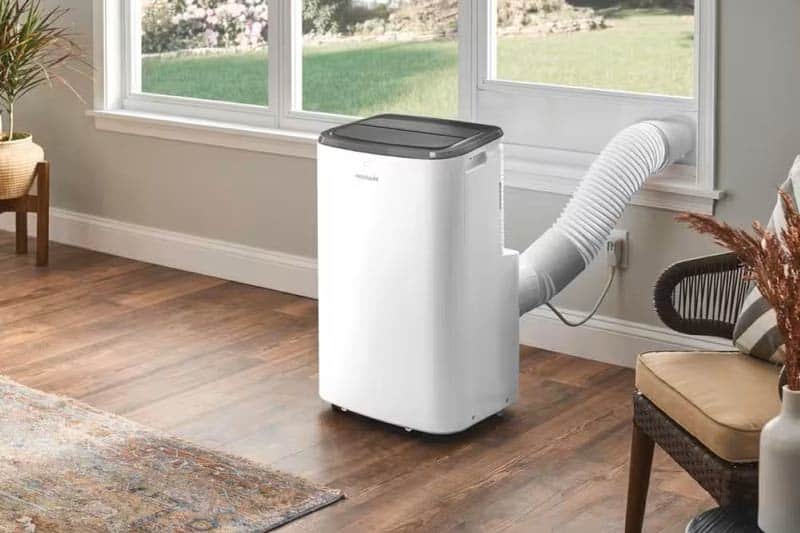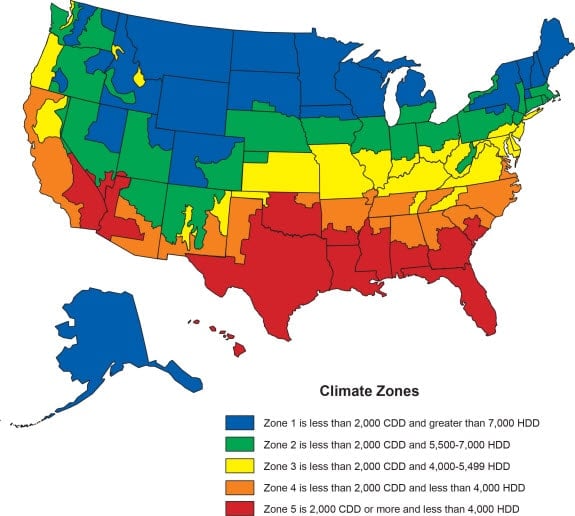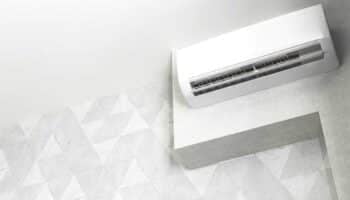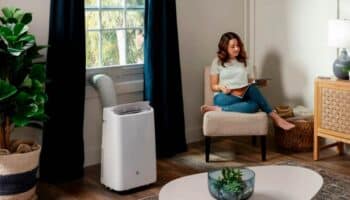Whether you’re a renter or homeowner, there’s a lot of choice when it comes to AC.
Today, we’re going to talk about the differences between single vs dual hose portable air conditioners—hopefully making the process of choosing easier for you. How? By giving you all the info you need, so that you can make an educated decision.
Single hose portable air conditioners are generally easier to install, and since they tend to be more affordable, they’re a budget-friendly option. However, dual hose units are generally more efficient than single hose models, and they’re capable of cooling your space quicker.
Want to know more? Keep reading!
Single vs Dual Hose Portable Air Conditioners
The main difference between these two is pretty obvious. One style has one hose, and the other has two.
Very simply put, a single hose unit collects hot air from the room, passes it over an evaporator coil that contains refrigerant, cools the air, and blows it back into the room. However, at the same time, some of the air is exhausted out of the room through the hose. And this happens over and over again while your air conditioner is running.
In contrast, with a dual hose unit, one hose is used to draw hot air from the room while the other is used to vent hot air outside.
But there’s a lot more to think about, so let’s look at the following categories and make some comparisons.
Upfront Price
First up, many people are cost-conscious these days, so what are the price differences between the two?
In general, you’ll find dual hose portable air conditioners more expensive than single hose units and this could be because they’re typically considered to be more efficient and effective. Meaning they do a better job of cooling your home while costing you less.
Take a look at the pricing below, but keep in mind that these are just general price ranges, and that individual models can vary in price based on the following:
- Features
- Air Conditioner Brand
- Energy efficiency
- …and more
Examples:
- Basic, entry-level single hose portable air conditioners can cost between $150 and $350.
- A basic, entry-level dual hose portable air conditioner typically runs between $300 and $500.
- Moving up to mid-range units, single hose portable air conditioners may cost between $350 and $600.
- In the same class, a dual hose unit could cost between $500 and $800.
- Finally, for high-end models, a single hose portable air conditioner could cost between $600 and $1000.
- High-end dual hose units can range from $800 to $1500 or more.
Winner: Single Hose
If the upfront price is more important to you than any other factor, then clearly, the winner here would be a single hose portable air conditioner.
Energy Efficiency
Sometimes, you need to balance the upfront price of an appliance with its efficiency and the amount it costs you to run. That is certainly true when looking at air conditioners.
An air conditioner’s EER (Energy Efficiency Ratio) measures its cooling output compared to the amount of energy it uses. Dual hose units typically have a higher EER than single hose units, meaning they can provide more cooling for the same amount of energy.
Let’s use a midrange portable air conditioner as an example.
| Description | Single-Hose | Dual-Hose |
|---|---|---|
| Cooling area | 425 sq ft / 39.5 sq mt | 525 sq ft / 48.7 sq mt |
| Energy Efficient Ratio (EER) | 10 | 11.2 |
Another energy measurement is the Coefficient of Performance (COP). It measures the ratio of cooling output against the amount of energy consumed. Dual hose portable air conditioners tend to have a higher COP than single hose units, again, making them more energy-efficient.
Finally, let’s look at power consumption. Dual hose units tend to use less power than single hose units do to achieve the same cooling effect. This is because they’re better at venting hot air out of the room and, in turn, reducing the amount of energy they need to cool any given space.
Winner: Dual Hose
In terms of energy efficiency dual hose air conditioners are a clear winner.
Installation
For the most part, the installation process of both single and dual hose portable air conditioners is relatively straightforward and easy. Having said that, there are a few differences between the two, with the installation of a dual hose unit being slightly more complex—but only because of the extra hose.
Both single and dual hose units come with the window kit, which is used to securely seal either one or two hoses in place and prevent any air leaks. So clearly, if your plan is for a dual hose unit, you need to be sure your window choice is large enough to accommodate both hoses.
Also, keep in mind that whatever the distance between your air conditioner and window, you’ll potentially have two hoses running across the room. So a dual hose unit means you may need the floor space for two hoses as well.
Winner: Single Hose
I’m classifying a single hose unit as the winner, but it should probably be a tie. While there is a tiny bit more work involved in attaching two hoses instead of one, the bigger issue may be available space.
Noise
Generally speaking, there could be some difference in noise levels between single and dual hose units, but this is mostly due to differences in their design and way of operating.
Since single hose models have only one fan working to both cool the room and expel hot air, they tend to be quieter than their dual hose counterparts.
On the other hand, dual hose models have two fans working in tandem to cool the room and expel hot air, and they’re potentially louder.
Having said all that, it’s important to note that noise level will vary widely depending on your model of choice, the manufacturer, and even the room you use it in.
For example, the Whynter ARC-102CS is a single hose unit, and it’s one of the quietest portable air conditioners on the market at 51 dB. But the Whynter Elite ARC-122DS, a dual hose, is just a single decibel noisier at 52 dB.
If noise is a factor in your decision-making process, manufacturers will report noise levels in decibels (dB), and the lower the rating, the quieter the unit. Pay attention to that instead of whether the unit you’re looking at is single or dual hose.
You might want to look at specific features that address noise as well. Some models may have “Quiet” or “Sleep” modes that will reduce noise further by adjusting fan speed or compressor operation.
Winner: There Is No Clear Winner
While in theory, a single hose unit should be quieter than a dual hose, that’s not the deciding factor. As pointed out in our example above, you can find dual hose units that will sound pretty much the same.
Power Usage

Generally speaking, single hose portable air conditioners tend to use less power when compared to dual hose models. The main reason for this is that dual hose units will use more energy to operate the second hose, which is used to expel hot air out the window while the other hose pulls in outdoor air to cool the condenser.
That process alone can result in higher power consumption when compared to single hose units.
However, it’s important to note that even though a dual hose model will use more power, it’s also using that power more efficiently. It can cool your area faster and more effectively, which can ultimately lead to reduced power consumption.
To better explain, thanks to their higher efficiency, a dual hose unit may have a shorter run time when compared to a single hose model. Since it cools the room faster, that dual hose unit can reach your desired temperature sooner and cycle off more often, leading to an overall reduction in power consumption.
Lastly, it’s impossible to quantify power consumption on the type of unit alone — single hose or dual hose. Power consumption can and will vary depending on specific models, sizes, manufacturer, and features. It’s very possible to buy dual hose units that have lower rated power consumption specifications.
Winner: There Is No Clear Winner
Theoretically, a single hose unit will use less power than a dual hose. However, since a dual hose is more energy efficient it can ultimately use less power. Additionally, better built models may be designed to use less power regardless of type.
Wondering About Features?
Without comparing two specific models — one single hose and one dual hose — it’s impossible to share feature comparisons. However, it’s probably good to know that most portable air conditioners, regardless of type, will have the following features.
One thing to note though, instead of assuming that any specific model you’re looking at has one of the following features, be sure to check its specifications to ensure it has the feature you’re looking for.
Temperature controls. Both types will allow you to adjust the thermostat to a specific desired temperature using either a digital or manual control panel.
Fan speed settings. Three fan speeds — low, medium, and high — that allow you to control the intensity of airflow and cooling are typical regardless of type.
Timer function. This feature allows you to set a specific time for the air conditioner to turn on or off automatically. It can ultimately help save energy and ensure your unit’s operating when necessary.
Dehumidification. Many portable air conditioners have a dehumidifier function that will help reduce the amount of excess moisture in the air. If you live in a very humid environment, this is a very desirable feature.
Remote Control. I don’t really need to explain the advantages of a remote, do I? They’re super convenient, and they’re common features with either single or dual hose models.
Choosing the Right Size

There’s something else that should be mentioned.
Deciding between a single or dual hose unit should be second to ensuring you’re buying the right size. Because buying a more efficient dual hose model will be a waste of money if it’s either oversized or undersized.
So how do you know you’re getting the right size?
Actually, there’s quite a bit to consider!
The Size of the Room or Area You Need to Cool
First of all, you need to understand that not one of the following considerations exists in its own little vacuum or space. In most cases, they all impact each other and can change the final outcome.
That means there is no X + Y = Z. It’s more like X + Y – (A + B – C) = Y.
To get started, you can use the following as a guideline, understanding of these numbers are just estimates, and that you’ll need to factor in your climate, and a few other things before arriving at the perfect size.
| Portable AC Size in BTUs | Square Footage (Meters) |
|---|---|
| 8,000 BTUs | 200 to 300 sq feet (18-28 sq meters) |
| 10,000 BTUs | 300 to 450 sq feet (28-42 sq meters) |
| 12,000 BTUs | 450 to 550 sq feet (42-51 sq meters) |
| 14,000 BTUs | 550 to 700 sq feet (51-65 sq meters) |
| 18,000 BTUs | Larger areas such as open floor plans, large living rooms, or multiple connected rooms. |
Climate Zones
The biggest factor that will come into play after determining the square footage of your room or area, is the climate you live in. If you’re in a very hot climate region, you’ll need more BTUs, but if you’re in a cold region you can get by with less.
For those in hotter regions, you can multiply your square footage by 10 to 15 to help come up with a ballpark calculation of your cooling capacity. Refer to the map above to find your climate region if you’re in the US.
Other Environmental Issues
There’s a lot of different things that make everyone’s home unique and some of them will impact the size of air conditioner you need. To understand what they are, Energy Star lists several things to take into consideration when sizing an air conditioner of any kind.
- If your home is in direct sunlight
- If the area you want to cool also has a window that faces the sun
- How high your ceilings are
- Any appliances or electronics that produce heat that are in the same room or area
That means if your home is in direct sunlight and you’re thinking about placing your portable air conditioner in a room that has a window with direct sunlight you’ll need a larger cooling capacity to not shown in the table above.
A rule of thumb is to increase the cooling capacity by about 10% if your impacted by any of the bullet points listed above.
Choosing the wrong size air conditioner can lead to the following issues:
- Short cycling
- High humidity
- Uneven or inadequate cooling
- Higher energy consumption and costs
- More noise
- Longer runtimes
Conclusion
So, are you wondering whether you should purchase a single or dual hose portable air conditioner?
Let’s recap.
Choose a single hose air conditioner if:
- You’re looking for lower upfront costs
- Easier installation
- Less noise
Choose a single hose air conditioner if:
- You’re looking for better energy efficiency
- Quicker cooling
However, as highlighted above, there will be some cross-over when comparing single and dual hose units. In most cases, there really aren’t any absolutes because a better-quality dual hose unit, from a better manufacture may, for example, be much quieter than a cheaper single hose model.
Hopefully, this information has helped you decide on the perfect portable air conditioner — for you.
While you’re here, why not check out some of our related posts below? Perhaps we can help you with something else.








